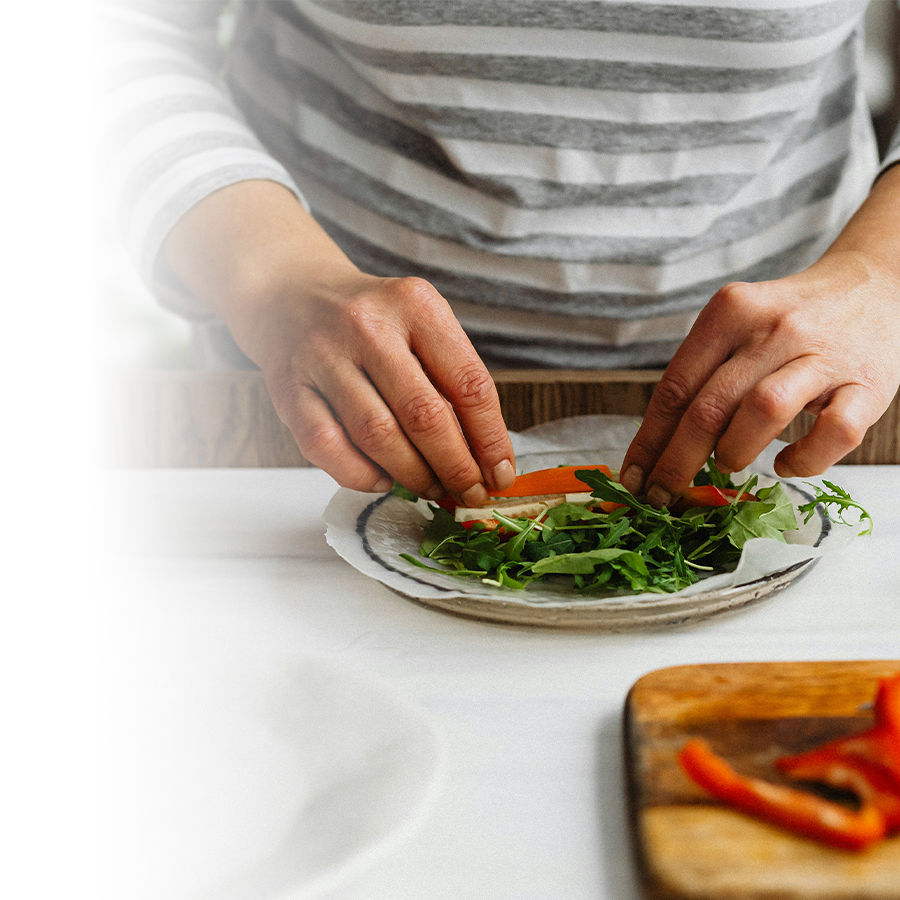Good nutrition is the key to managing type 2 diabetes on a daily basis. Learn about the essential dietary habits to adopt for better control of this chronic disease, which accounts for 90% of all cases of diabetes.
Managing type 2 diabetes is closely linked to diet
Healthy eating is crucial for managing your diabetes and glycemia (blood sugar levels) in real time, but it becomes especially important in cases of type 2 diabetes, which is more influenced by lifestyle. In addition to keeping blood sugar at a normal level, adopting good eating habits helps prevent several health problems associated with type 2 diabetes, such as obesity or cardiovascular disease. It's also a good way to reduce the risk of complications or the need for medication.
Type 1 and type 2 diabetes: make the distinction!
- Type 1 diabetes is a disease in which the pancreas does not produce enough insulin, which means daily injections of this hormone are required. This type of diabetes can occur at any age, but is more common in childhood and adolescence.
- Type 2 diabetes results from the body's resistance to insulin. Much more widespread, this type of diabetes is often associated with obesity or a sedentary lifestyle. It is generally diagnosed in adults aged 40 and over.
Unlike type 1 diabetes, where insulin must be administered to manage blood sugar levels, type 2 diabetes can sometimes be controlled by diet and healthy lifestyle habits alone. So, diet is particularly important for living well with type 2 diabetes. Here are 10 eating habits to adopt for good disease management.
1) Focus on complex carbohydrates
Unlike simple carbohydrates, which cause rapid spikes in blood sugar, complex carbohydrates are digested more slowly, allowing a gradual release of glucose into the bloodstream. This makes it easier to stabilize blood sugar levels.
Some complex carbohydrates to choose from:
- Starchy foods, such as sweet potatoes, potatoes and squash;
- Legumes, such as lentils, chickpeas, black beans and kidney beans;
- Whole grains, such as oats, quinoa and brown rice.
And simple carbohydrates to avoid:
- Honey and white sugar;
- Sweets and confectionery;
- Sodas and sugary drinks;
- Cakes and pastries;
- White bread.
2) Eat balanced, portioned meals at regular intervals
To manage type 2 diabetes optimally, it is essential to eat balanced meals on a regular basis. This habit not only prevents blood sugar peaks and drops, but also has a positive impact on mood and energy levels!
A well-balanced diet includes the following elements:
- Meal composition: Every meal should include complex carbohydrates, proteins and healthy fats that slow digestion and stabilize blood sugar levels.
- Meal frequency: Eating at regular times helps regulate the body's insulin cycle and manage hunger. For some people, three meals a day is enough, while others may need small snacks between meals to keep blood sugar levels constant, especially if they're using anti-diabetic medication or insulin.
- Portions: Too much food at a meal can cause hyperglycemia (a significant rise in blood sugar), even with healthy foods! So, it's a good idea to use smaller plates, measure portions with cups or scales, and check nutrition labels to manage the amount of food consumed.
Here's an example of a well-balanced menu
- Breakfast: Oatmeal with fruit or Greek yogurt with nuts.
- Dinner: Legume salad with grilled chicken and olive oil vinaigrette.
- Supper: Baked salmon served with quinoa and grilled vegetables.
Above all, never skip a meal!
Missing a meal can result in hypoglycemia (a significant drop in blood sugar levels), which can lead not only to fatigue and irritability, but also to overeating at the next meal to compensate, which in turn can result in a blood sugar spike.
3) Focus on fibre and protein
Incorporating fibre and protein into every meal is crucial to maintaining good health, especially for people with type 2 diabetes. These nutrients are essential not only for regulating blood sugar levels, but they also help you to feel full and manage your weight more effectively.
- Foods that contain fibre like vegetables, fruits with skin, legumes, nuts and whole grains are just the thing to slow glucose absorption and better control blood sugar. Soluble fibres such as beans, oats and fruit are particularly recommended as they lower blood cholesterol levels, which is beneficial for diabetics at increased risk of cardiovascular disease.
- Proteins such as lean meat, fish, eggs and low-fat dairy products have no impact on blood sugar levels, making them particularly useful for diabetics. They also support cell repair and muscle growth, as well as helping to keep you feeling full, so you don't snack between meals.
4) Avoid saturated and trans fats
People living with type 2 diabetes must limit their intake of saturated and trans fats, as they can increase the risk of cardiovascular disease, which is already higher in diabetics. Instead, opt for the healthy fats found in avocados, nuts, olive oil and oily fish.
- Saturated fats are found mainly in animal products such as red meat, butter, cheese and cream, as well as in certain tropical oils such as palm and coconut oil.
- Trans fats, on the other hand, are often found in processed foods, fried foods and certain snack foods such as potato chips and cookies.
A few ways to reduce bad fats:
- Choose leaner cuts of meat, skinless poultry, or plant-based protein sources such as tofu and legumes.
- Use cooking methods that require little or no added fat, such as grilling, steaming or baking.
- Read labels carefully to avoid products containing hydrogenated or partially hydrogenated oils, which are sources of trans fats.
5) Limit alcohol consumption
Alcohol can cause blood sugar to rise as well as fall, which obviously complicates glycemic control. It can also interfere with diabetes medications. All good reasons to limit your alcohol consumption by following these practical tips:
- Limit your alcohol consumption to one drink or less per day for women and two drinks or less per day for men.
- Drink alcohol with food to mitigate its impact on blood sugar.
- Choose alcoholic beverages with less sugar and calories, such as dry wine or light beer.
6) Stay hydrated
Drinking enough water every day is obviously important for everyone, but probably even more so for people with type 2 diabetes. In fact, proper hydration helps to eliminate excess glucose in the urine and maintain good kidney function. As far as possible, avoid sugary drinks, which can raise your blood sugar levels and dehydrate you.
It is recommended to drink around two litres of water a day, but this amount may vary according to your level of physical activity and general state of health.
7) Keep an eye on your salt intake
Too much salt in the diet can contribute to high blood pressure, a common condition among people with diabetes. So it's important to keep an eye on the amount of salt on your plate:
- Avoid prepared/processed foods, which are often higher in sodium;
- Limit the use of table salt when cooking;
- Replace the salt with herbs and spices for added flavour.
8) Monitor blood sugar levels regularly
Monitoring your blood glucose levels regularly is essential for effective management of type 2 diabetes. This habit allows you to adjust your diet, exercise routine and medication to maintain the right blood sugar levels.
Here are the recommended glycemic control targets for most people with diabetes:
- Between 4 and 7 mmol/L before meals;
- Between 5 and 10 mmol/L two hours after the start of a meal or snack;
- HbA1c (glycated hemoglobin, which indicates the average of your blood glucose levels over the past 3 months) equal to or less than 7%.
Blood glucose meters: Essential for better monitoring
Using a glucometer allows you to check your blood sugar levels at key times of the day, including before and after meals, before and after physical activity, and before bedtime. These are essential devices to help you make quick, informed decisions about your diet or physical activity to keep your blood glucose levels at an optimum level.
In addition to using a glucometer, consider adopting the following habits:
- Keep a diary of your blood glucose results to discuss with your doctor or pharmacist when you visit. Note variations in relation to meals, physical activity and medication to detect certain trends.
- Analyze trends in your blood glucose readings to identify when your blood glucose levels are higher or lower. Use this information to discuss possible adjustments to your treatment plan with your health care professional.
- Use a blood glucose tracking app on your tablet or smartphone. Many apps can help you record, visualize and analyze your glucose levels, making monitoring easier and more interactive.
Which glucometer to choose?
There are several different glucometer models on the market, each with its own characteristics. Some offer advanced features such as Bluetooth connectivity to synchronize data and simplify tracking. Ask your pharmacist to help you choose the best device for your needs.
9) Plan a menu for the week
Planning your meals for the week is an effective strategy for maintaining a healthy, balanced diet to manage type 2 diabetes. Planning your menus in advance ensures that you eat a variety of beneficial foods, while controlling portion sizes and avoiding potentially unhealthy last-minute decisions. It's also a great way to manage portions and balance your weekly meals with a good proportion of complex carbohydrates, protein, fibre, healthy fats, fruits and vegetables.
Here are a few tips for better planning:
- Consider your specific calorie needs, food preferences and the recommendations of your nutritionist or health care professional who monitors your diabetes.
- Prepare a detailed grocery list based on your meal plan to avoid unplanned impulse purchases that could sidetrack your diet.
- Set aside time on the weekend or at a time that suits you to prepare meals or meal components in advance. This can include chopping vegetables, cooking grains or proteins, and preparing healthy sauces or dressings.
- Include a variety of foods to avoid monotony. Have several options for the same types of meals to help maintain interest and satisfaction.
- Use meal-planning tools or charts can help organize your ideas and keep track of what you've eaten.
10) See a nutritionist or health care professional
For people with type 2 diabetes, regular visits to a nutritionist or health care professional who specializes in diabetes management are important steps in personalizing your diet, learning more about nutrition and making adjustments as needed.
Diabetes management is an ongoing process. Committing to a long-term partnership with your nutritionist or health care professional can help you maintain good health over the long term.
Don't forget your pharmacist!
Your pharmacist also plays a crucial role in managing type 2 diabetes by advising you on the correct use of medications, helping you understand potential drug interactions, and giving you practical advice on how to adjust your medication in response to fluctuations in your blood glucose levels. They are valuable and highly accessible resource for ongoing support. Make sure you take advantage of their expertise to optimize your diabetes management.


